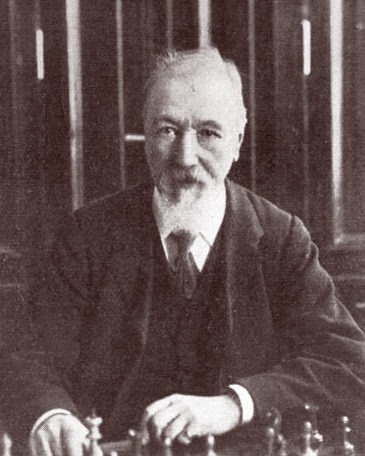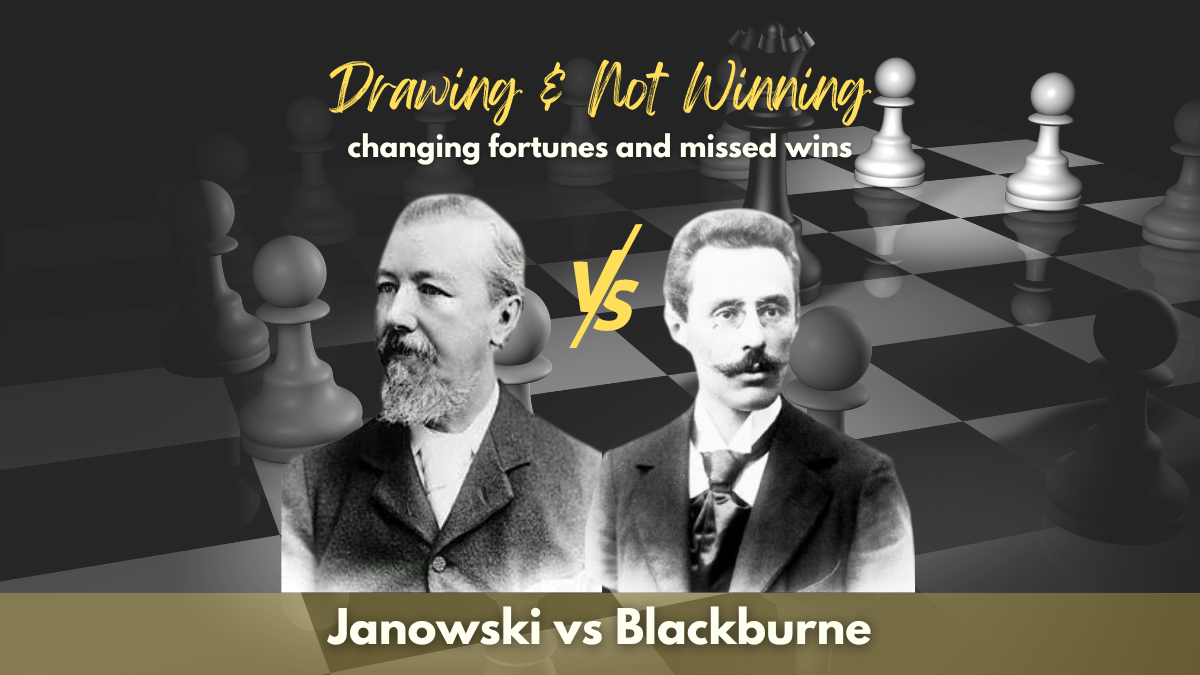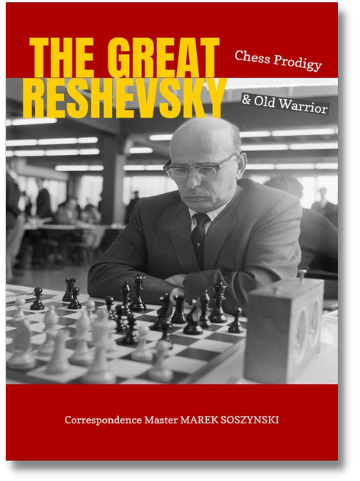Here’s an old game between the Polish-born Dawid Janowski (1868-1927) and the Englishman known as “The Black Death,” Joseph Blackburne (1841-1924). At the time of the game, the pair were among the world’s top twenty chess players. Here they take part in a typical tournament tussle involving changing fortunes and missed wins.

credit: chesshistory

credit: britishchessnews
1. e4 d5 2. exd5 Nf6 3. d4 Nxd5 4. c4 Nf6 This was the favored continuation at the time. The “hypermodern” but now standard 4… Nb6 typically accompanied by a kingside fianchetto was a later invention.
5. Nc3 e6
5… e5 All because on his 5th move White played a knight to c3 rather than to f3. 6. dxe5 Qxd1+ 7. Nxd1 Ne4.
6. Nf3
A position also reached by 1.e4 e6 2.d4 d5 3.exd5 Qxd5!? 4.Nf3 Nf6 5.c4 Qd8 6.Nc3.
6… Nbd7
6… Be7 7. Bd3 O-O 8. O-O b6 is a more usual line.
7. Bd3 c5 8. d5 Nb6
Uncastled Black must be careful about opening the position: 8… exd5 9. O-O d4 10. Nb5 a6 11. Qe2+ Be7 12. Nd6+ Kf8 13. Nxf7 Kxf7 14. Ng5+ Ke8 15. Ne6.
9. dxe6 Bxe6 10. b3 The c-pawn doesn’t need protecting.
10. O-O Bxc4 (10… Nxc4 11. Re1 Na5 12. Ng5+-) 11. Qe2+ Be6 12. Bb5+ followed by Nf3-g5 is very bad for Black.
10… Bd6
Black, who isn’t equal yet, has several options, including 10… Qd7 perhaps with queenside castling.
11. O-O O-O 12. Bg5 Be7
It seems wasteful to move the bishop again but White was threatening 13. Bxf6 Qxf6 (13… gxf6 14. Qc2 ) 14. Ne4! Qe7 15. Nxd6 Qxd6? 16. Bxh7+ gaining the queen.
13. Qc2 h6 14. Bh4 Nh5?! Black is struggling to impose his own will on the game, so he tries something fanciful. 15. Rad1
55…Nd7 Others are worse because the black queen will be bullied by the white pieces:
15… Qc7 16. Nb5!
15… Bd7 16. Bxe7 Qxe7 17. Bh7+ Kh8 18. Rfe1 Qf6 19. Ne4 Qf4 20. Nxc5 +-
16. Bg3? A massive relief for Black who can now redeem his wayward knight by dissolving White’s bishop pair.
White doesn’t appreciate the fine position he had achieved through his assertive opening play, which he should continue with 16. Bxe7 Qxe7 17. Bh7+ Kh8 18. Rfe1 threatening Bh7-f5 and/or Nc3-d5, alternatively Bh7-e4-d5. And note the further possibility Qf6 19. Rxe6 Qxe6 20. Bf5+-
16… Nxg3 17. hxg3 Qc8 18. Rfe1 Nf6 White is still better but this relatively “normalized” situation is slightly less dangerous for Black than it had been. 19. Nh4 Re8 20. Bf5 Bf8
21. Nd5 Nxd5! 22. Bh7+
22. Rxe6! is White’s last little trick in this phase of the game. Fortunately, it isn’t nasty for Black as long as he saves his knight rather than takes the rook. Nb4! (22… fxe6 23. Bh7+ Kh8 24. cxd5 Qc7 25. Be4) 23. Rxe8 Qxe8 24. Qb1 Nc6=
22… Kh8 23. cxd5 White regains his piece although by now Black has more or less equalized. Bg4 24. f3 Bd7 25. Be4 Bd6 26. f4 Bg4 27. Rc1 Qc7 28. Bf5 Bxf5 29. Nxf5 Bf8 30. Qc3 Qd7 31. Qd3 g6 32. Ne3 Rad8
33. a3 b6 34. f5? White is going wrong. It can’t be due to the clock because he’s only just passed the first time control (30 moves in 2 hours). Bg7 35. fxg6 Bd4!
Even if Black follows White’s plan with 35… fxg6 what is White’s follow-up supposed to be? 36. Qxg6?? loses to 36…Bd4! 37. Qxh6+ Qh7 (37… Kg8? 38. Rcd1) 38. Qg5 Rg8 39. Qf4 Rdf8.
36. Kh2 Re5 37. g4 Qd6 This looks attractive because of a discovered check, but White easily guards against that possibility.
Best is 37… fxg6! 38. Nc4 (38. Qxg6 Rxe3 39. Qxh6+ Qh7-+) 38… Rxe1 39. Rxe1 Qxg4-+
38. g3 Qxg6 39. Qxg6 fxg6 40. Nc4 Rexd5
41. Re6 (41. a4 stops Black’s next move.) 41… b5 42. Na5 Bb2
42… R5d6! 43. Rce1 R8d7 looks like a better way to play for a win.
43.Rf1 R5d6 44. Re7 R6d7 45. Re6 Rd6 Repeats the position (once). Yes, there were already some sort of “draw by multiple repetition” rules back in the nineteenth century. So Black, a pawn up, doesn’t want to fall foul of them.
45… Rc8! transposes to the next note (featuring 47…Rc8!).
46. Re7
46… Rd1? The win is gone.
It was still possible with 46… R6d7 47. Re6 and now (not 47…Rd6 which is a third occurrence but) Rc8! with the idea of forcing the c-pawn (or another) toward a queening square. The knight can’t stop that, for example, 48. a4 (48. Nc6 c4 49. bxc4 bxc4 50. Nb4 Bxa3-+) 48… bxa4 49. Nc4 axb3! when White can take the bishop but is faced with three passed pawns, which he cannot overcome.
It isn’t possible to detail everything, but another line after 46… R6d7 is 47. Rf8+ Rxf8 48. Rxd7 Rc8 49. Rb7 Bc3 50. Rxb5 a6 51. Rb6 Bxa5 52. Rxa6 Bd2 53. Rxg6 Bc1, which is also a forced win for Black — eventually.
47. Rxd1 Rxd1 48. Rxa7 Rd2+ 49. Kh1 Bxa3 50. Rb7
50…Bb4 (50… b4 51. Rc7 =!)
51. Nc6 Rb2 52. Rxb5 Rxb3 53. Kg2 Kg7 54. Kh3 Re3 55. Nxb4 cxb4 56. Rxb4 Kf6 1/2-1/2
Play through the whole game here:
If you liked this little trip down history, be sure to check out the author’s book on another chess giant, Sam Reshevsky:

Marek Soszynski is a master twice over: a Master of Philosophy and a Correspondence Chess Master.
He is the author or co-author of several chess books, including “The Great Reshevsky”, “The Polish Defense”, and “Sabotaging the Sicilian French & Caro-Kann with 2.b3” which you can find on Forward Chess.
He lives in the city where he was born, Birmingham, England.
- The Power of Pattern Recognition: The Woodpecker Method 2 - August 20, 2024
- Rock Solid Chess: Volume 2 - February 21, 2024
- Unsung Heroes of Chess - February 19, 2024

